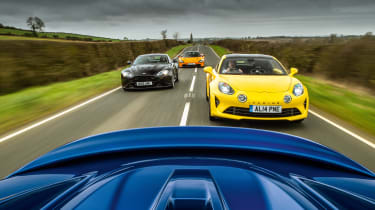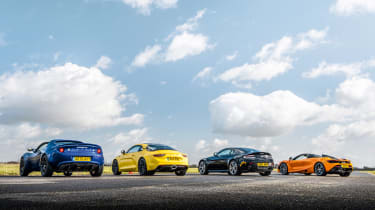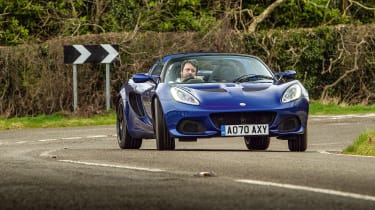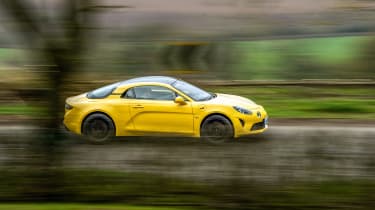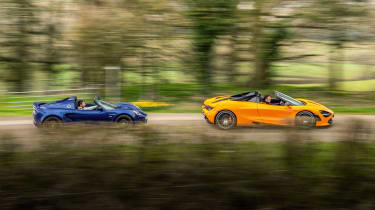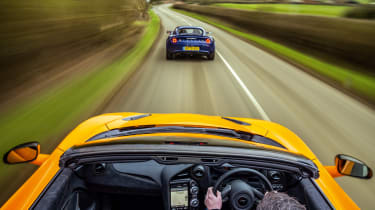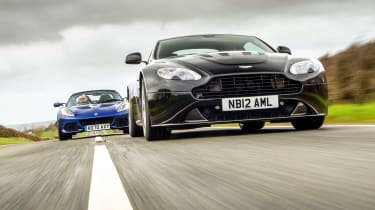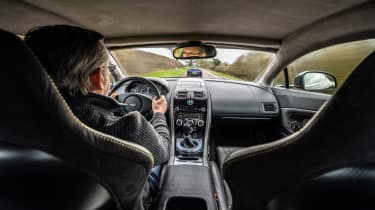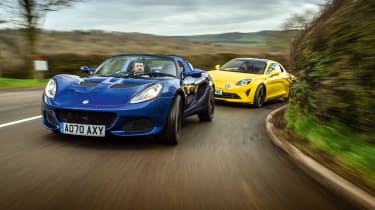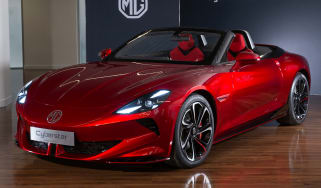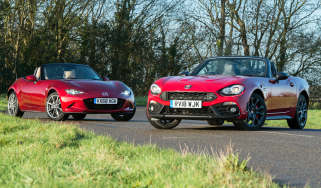Lotus Elise v Alpine A110 v Aston Martin V12 Vantage v McLaren 720S
Now that the Lotus Elise has been waved off, we celebrate its enduring genius by bringing it together with three of the cars it inspired
Thumb the button. Feel the barrel ‘click’ with the lock mechanism. Swing the door open, step over the sill, twist your torso as your hand grabs for the seat and then fall into that oh-so-familiar cockpit. Hello Elise, it’s been a while and it’s good to be back.
Can it really be 26 years since Julian Thomson’s diminutive roadster first stole magazine headlines? How has the Elise survived all that Lotus has got itself into over the last two and half decades? How can this iconic British sports car still be a benchmark when it comes to experiencing the thrill of driving in its purest form? How many ordered a 240 Final Edition when Lotus announced that they were the last that you will be able to buy a new factory-built Elise? Quite a few, I imagine.
> 2022 Lotus Emira review – strong showing for Porsche Cayman GTS rival
evo has been a champion of the Elise ever since we launched 24 years ago. In fact an example graced the cover of issue 000, our ‘dummy’ edition that we used to show the industry what we were all about, because no car conveyed evo’s DNA better than an Elise. It starred in the very first eCoty, the Sport 135 finishing second, and it has been a constant presence over 303 issues. With the arrival of every subsequent new sports car, it has been our go-to benchmark, setting the standard all others had to beat. Not many did.
But the Elise reaches beyond the lightweight sports car sector. When any manufacturer claims outstanding steering, it’s the Elise that’s the reference point. Exquisite ride and handling with telepathic feedback? Well, how does it compare with Norfolk’s evergreen hero, a car that nailed steering precision and feel, and ride and handling 26 years ago?
The Elise has also consistently proven that size and weight not only define a car in terms of how it can be used, but that both are intrinsically linked to how it drives. That good engineering and innovation stand the test of time far longer than the latest piece of headline-grabbing technology. Get the engineering and design right the first time and you won’t need to constantly revise it to stay relevant.
And that has been the Elise to a tee. The principles that underpin it remain exactly the same today; carried through from S1, all the way through the Vauxhall-funded S2 era to today’s S3 iteration, now in its 11th year of production.
To mark the approaching end of an era – and to show just how far and wide the Elise’s influence has spread – we’ve assembled a rather eclectic group of cars. An Alpine A110 is the obvious invitee to our small gathering. Not to decide who does it best, but to highlight and explain why compact dimensions, agility and a lightweight philosophy play such an integral role in elevating the very best above the merely good when it comes to driver’s cars.
At the other extreme is McLaren’s 720S. A supercar that redefines ride and handling in its own sector with an other-worldly ability to flatten every surface it covers. Matched with hydraulic steering that’s clean, precise and rich in detail, Woking’s mid-engined rocketships are often described as Lotus turned up to 11.
And then there’s the brooding Aston Martin V12 Vantage. Like Lotus, Aston Martin needed innovation if it was to survive as the new millennium dawned and its VH platform, closely aligned in principle and execution to Lotus’s extruded aluminium chassis, allowed Gaydon to develop a family of cars that have not only stood the test of time, but allowed it to survive long enough to embark on its own renaissance under new owners.
Three very different driver’s cars, all inspired by one iconic hero.
Lotus Elise Sport 240 Final Edition
Lotus didn’t invent lightness, but it was the fervour with which it pursued the mitigation of mass that set the company and its cars apart. The Elise was never the lightest ‘proper’ Lotus road car – the original eggshell Elite weighed just 503kg – but it is surely one of the best expressions of the pursuit of lightness. Especially as it came at a time when cars were not only getting heavier, but relying on ever-increasing power to go faster.
Here was a car that bucked that trend in unique fashion, chasing pure and simple pleasures with breathtaking singularity of purpose. It was this mindset that dictated packaging and refinement were secondary to lightness and efficiency. Too tall? Tough luck. Too much NVH? Buy an MX-5. Weight was the enemy to be repelled at all costs. Well, all costs apart from financial ones. This was Lotus, after all: a company that prides itself on development budgets as skeletal as the cars.
Want further evidence of the Lotus ethos? Look no further than the MG F. Launched less than 12 months ahead of the Elise, the MG was also a millennial, mid-engined two-seater. It even shared the same Rover K-series powertrain. We’ll ignore the fact it wasn’t blessed with deft lines penned by Julian Thomson, and instead we should focus on weight alone. Kerb weight for the 1.8i MG F? 1060kg. Kerb weight for the S1 Elise? 725kg. Take a bow Mr Richard Rackham, chief engineer on the Elise project and one of the most modest yet brilliant people you could ever wish to meet.
It’s hard to conceive of a car that cost so little, yet introduced so many genuine innovations. The bonded aluminium chassis gets all the plaudits, but the Metal Matrix Composite brakes are forgotten stars of the show. Not because they didn’t work in a road car application (you just needed to understand the principle of adherent friction versus conventional abrasive friction), but because US-based Lanxide Corp – the company that pioneered the manufacturing process for the lightweight silicon carbide aluminium discs – went bankrupt.
Another oft-overlooked quality of the Elise was its intuitive understanding of how minimising a car’s footprint cannot fail but maximise its on-road exploitability. With more room to play with, you don’t need to keep a car so rigidly clamped down. Freed from the need for magnet-like road-holding, the Elise’s tyres could be skinny, which in turn negated the need for wide, heavy wheels. Likewise power-assisted steering.
The result was a car that flowed like water, gracefully preserving momentum where bigger, heavier, more powerful cars required a degree of roughhousing to extract their speed. There’s no such thing as the perfect driver’s car, but the Elise was about creating virtuous circles within circles: literal, metaphorical and philosophical. Zen and the Art of Sports Car Engineering.
Alpine A110
It’s no coincidence that of all the sports cars to come and go between then and now, the one that resonates most is the Alpine A110. For starters it’s breathlessly pretty. It also relies upon a powertrain derived from more humble hot- hatch stock; a rare example of thrifty and nifty being one and the same.
Given the collective awareness of how a lighter sports car is – in theory at least – always better than a heavier one, it’s bemusing how truly lightweight sports cars are like comets, only brushing our consciousness every few decades. You’d think we’d have nailed it by now, yet the A110’s razzle-dazzle is almost entirely due to its pursuit of lightness.
A look back through the evo archives confirms as much, with Alpine’s then MD, Michael van der Sande, nailing what it is that continues to make the A110 a stand-out sports car in the Elise mould: ‘A very lightweight sports car that punches above its weight in terms of performance is very relevant, not just in the ’60s and ’70s, but also today.’
The engineering team behind the A110 were fanatical about weight, which is why the scales tipped at 1103kg. The class-leading Porsche 718 Cayman, benchmarked by Alpine’s engineers throughout the development process, was more than 230kg heavier. The A110’s aluminium structure alone is reckoned to have saved 180kg compared with a steel one, while the very compact dimensions – the A110 is 20cm shorter than a Cayman – also helped to keep weight down.
Obsession was an intrinsic part of the Alpine’s genesis, as evidenced by chief engineer David Twohig’s admission that he lost sleep toying with the idea of fixing the passenger seat in position. Eventually he decided the 500g saving wouldn’t have been worth the inconvenience, but as ever it’s the thought that counts.
Funnily enough, just as the Elise was scaled around engineer Rackham and designer Thomson (both compact chaps), so the Alpine was built to accommodate van der Sande. Perhaps if the boss’s frame hadn’t measured a full six-foot-seven (the 99.9th percentile for height) the A110 could have been smaller and lighter still. Then again, if vdS hadn’t pushed the project with such passion, mission creep would surely have manifested itself in less obvious areas.
The parallels between Elise and A110 are uncanny. For starters the aluminium construction of the latter is almost entirely informed by the former, with a combination of 800 rivets and 6kg of glue holding the chassis structure together. It goes a step further than the Lotus, in using aluminium for the bodywork instead of glassfibre. And, of course, the engine shares a capacity of 1.8 litres, albeit augmented by a turbocharger and mated to a seven-speed paddleshift transmission.
As with any comparison separated by decades, context is everything. Drive an Alpine immediately after an S1 Elise, or indeed an S3 Elise, and it feels larger and heavier than it needs to be. Yet if you accept the Elise to be the throwback that it is, the Alpine stands alone.
No pun intended, but there’s a lightness of touch to everything the A110 does. From the smooth, unadorned profile that speaks of smart underfloor aero to the delicate design details that pepper the entire car, the Alpine reeks of knowing, thoughtful engineering. You feel the difference from the moment you open the (light) driver’s door, and from there you can enjoy the benefits of avoiding unwanted weight in everything it does.
Power-assisted steering lacks the purity of the unassisted Elise, but ironically it’s also considerably heavier than the S1’s unnerving lightness, which felt for all the world as though the car had been set on axle stands and the front wheels removed. Both have a mildly unsettling lack of feel for the first split-second of steering input, but familiarity brings the confidence to commit knowing the car is under you. Deftness and clarity is an Alpine trait, as is suppleness and an ability to work with the road. It sets the tone for a driving experience that majors on subtlety, precision and the ability to build a tight bond between car and driver.
Looking back once more to early coverage in evo, Steve Sutcliffe – a man who has been testing cars across four decades (sorry mate!) – knew the bold new Alpine was the real deal from the moment he rode in it: ‘The A110 glides across the ground in a similar way to an early Elise, in that it appears to have huge grip and composure but also a beautifully fluid ride. There are no harsh edges to its responses. Instead, the springs and dampers appear to be able to deal with just about anything they encounter.’
His words proved prescient, for from the moment we drove the A110 we knew it was something truly special. Indeed, that belief has been borne out in the fact we prefer the regular A110 to the A110S – a car that promises more on paper, yet in our opinion only serves to underline the validity of a less-is-more approach. What’s beyond doubt is that both models stand alone in pursuing a path of performance that sets the A110 apart from
even its deadliest and most accomplished rival, the Porsche Cayman.
Ultimately the Alpine tugs at the same heartstrings as the Elise, only with a little more panache (quilted leather anyone?) and more concessions to daily driving. In terms of an outright expression of purity, an early
Elise remains the benchmark, but there’s no doubting that if Alpine hadn’t adopted a Lotus-like approach to
the design and development of the A110 it could easily have ended up being a latterday MG F. Or worse, a French Alfa 4C, arguably one of the 21st century’s greatest sports car travesties.
As it stands, the Alpine is testament to the enduring validity of the Elise’s exacting code. All credit to those who made it happen. Few cars at any price feel so special, which only confirms that lightness equals rightness.
McLaren 720S Spider
Mention Lotus Cars to McLaren high-ups and, in an official capacity at least, you’re unlikely to hear how former Lotus employees and Lotus chassis tuning DNA run like a thread through the company. Which rather goes against anecdotal evidence and the career back-stories of a number of key engineers. One thing is for sure: drive a McLaren and you can’t help but have those five letters – L, O, T, U and S – drift to the forefront of your mind.
Why exactly is that, though? Today I’m at the wheel of a very orange, explosively powerful 720S Spider. Am I really trying to draw a parallel between it and a tiny lightweight sports car launched 25 years ago with just 118bhp?
Of course, there are the obvious similarities in layout: the 720S is a low, mid-engined car, of monocoque ‘tub’ construction with just two seats, and, as this is the Spyder, the roof lifts off, too. But such a layout is hardly unusual, and there are multitudes of mid-engined sports cars that feel nothing like a Lotus Elise once you’re behind the wheel. They can also feel ponderous, heavy and decidedly spiteful, and neither the Elise or 720S possess any of those traits.
Nevertheless, there are some obvious physical elements to the 720S that do relate to the Elise. When the venerable Lotus was launched, a tub construction was still relatively unusual, at least in the low-volume specialist sports car business. By adopting said method, Lotus ensured not only a stiffer core structure over spaceframe-based rivals, but also a much improved level of occupant safety in the advent of a shunt – just as happened in F1 during the late ’60s/early ’70s. The masterstroke of the Elise was to bond the aluminium together rather than physically fix it in place with welds and ironmongery, thereby reducing the weight of the overall car significantly.
Naturally, the McLaren is carbonfibre, a technology that replaced aluminium monocoques in F1 and other top-flight racing disciplines in the early-to-mid 1980s, but when you sit in the 720S the parallels are there, from the obvious chunky sills of a tub to that feeling of sitting in an all-encompassing cocoon that will protect you in the advent of a nasty side impact. That same sense of minimalist interior surfaces is present, too. The McLaren’s dramatically sculpted doors, pared-back dashboard and thin centre console feel as though the surfaces have been drawn tight by drawstrings, this visual and physical lack of interior ‘real estate’ echoing the Elise’s narrow shelf of a dashboard and tiny instrument binnacle. It’s a clear message that you’re sitting in a car where weight has been viewed as the enemy.
The pursuit of shaving off the kilograms is, of course, a key tenet of both brands. The 720S is nothing like as light as an Elise, naturally, but we’ve become used to McLarens undercutting the kerb weights of their supercar rivals, with that composite tub as a centrepiece but an attention to saving even mere grams running throughout the car. Take the new Artura, which despite an influx of heavy hybrid technology manages to weigh only 50kg more than the outgoing and conventionally powered 570S. It might not sound like much of a result when you read it on the page, but in engineering terms it’s glorious ‘back of the net’ stuff.
The philosophical inheritance from the Elise is only fully revealed once the 720’s wheels are rotating, and it starts with the steering. The Elise, of course, has an unassisted set-up, which even by Hethel’s admission becomes very difficult to do once past 1100kg and 205-section front tyres. Yet the McLaren has equally exceptional steering, in part perhaps because the firm refuses to budge from a hydraulic set-up to fully electric assistance, despite the tiny improvement in fuel consumption the latter brings. Even the electrified Artura retains its hydraulic system, purely because McLaren won’t compromise on steering feedback.
The precision and delicacy of the 720’s rack bears all the hallmarks of great Lotus assisted steering systems found in cars such as the Esprit: it’s neither too heavy or too light, neither too fast or slow. Its ratio is linear, and the biggest compliment you can pay is that after the first mile you no longer give it a second thought, instead feeling that you’re actually connected to the car in some physical way. You turn, the car turns. It’s as primeval as that.
Accuracy and precision are steering qualities that rival firm Porsche also imbues in its cars, particularly those from the GT department, but McLaren allows more ‘noise’ back into the car via the wheel, giving a truer picture of what’s happening down at the front wheels, if not to quite the same extent of loudness as the Elise.
The strongest legacy of the Elise surfaces in McLaren’s ride and handling doctrine, and I think back to driving the Senna on the North Coast 500 (evo 252). On hearing about that drive, most people’s reaction was: ‘That must have been uncomfortable, verging on unusable on those roads. Madness…’ The reality was completely opposite: the Senna was perfectly useable – often even in the more aggressive damper settings. At one point, travelling at unprintable speed, we hit a remote stretch of road that had virtually disintegrated for over a mile and I physically braced myself for the carnage and potential damage that was about to happen to a very expensive motor car. Yet the result was near silence, the Senna gliding over the road like a swan, the suspension hidden below the surface working furiously but sublimely to counteract the forces being put into it. I recall my mouth hanging loosely open in shock: I don’t think I’ve ever experienced suspension control quite like it.
The 720S Spyder shares the same Proactive Chassis Control 2 with its interlinked hydraulics and hideously complicated algorithms, but any McLaren, even those with a more conventional set-up, has never been afraid to use its springs and dampers to work with the road, rather than against it. It’s why the 720S could be a perfectly useable everyday supercar, its ride quality shaming some luxury cars in the way it parries bumps and holes. And it was the Elise that showed how, in the finest Lotus tradition, a stiff set-up didn’t necessarily make a car go faster. The featherweight Elise didn’t need overly firm spring-rates to control its mass because that mass simply wasn’t there. Instead it could be made to breathe with the road while retaining ruthless body control.
It’s that sense of flow that encapsulates driving an Elise even to this day, and it’s the principal quality that shines out when pedalling the McLaren, too. An economy of effort, a willingness to adapt to the texture of the road, to allow enough body roll to telegraph the limits, yet with enough control to keep momentum in check. It’s one reason why testers say that the 720S – a physically big car – ‘shrinks’ around them at speed. Driving it quickly it feels nimble, agile and malleable, and you find yourself exclaiming: ‘This feels like a giant, massively powerful… Elise!’ Truth is, a car that feels like it’s on your side, rather than something wild to be tamed, very quickly becomes a car to be exploited rather than feared, and that holds true even for a 700bhp supercar.
It’s often said that McLaren successfully created its own design language, but it’s also achieved the same from a dynamics perspective, meaning you’d instantly know when you were driving a McLaren even if being subjected to various sensory deprivation techniques. To achieve that takes clear goals carried through by engineers with priceless skills and experience. But the principles laid out in that internal handbook very much have their roots in Norfolk, and they’re all the better for it.
Aston Martin V12 Vantage S
In both the Lotus and Aston you sense a lack of inertia, but while it permeates everything the Lotus does, enhancing turn-in, agility and throttle response, in the Aston it’s only clearly evident in throttle response. And then only because this is the 5.9-litre V12 Vantage, the unlikely yet irresistible combination of Aston’s biggest engine in its smallest car. The Aston and Lotus are also linked at a fundamental level, though, because the aluminium platform at the heart of the Vantage is an evolution of the Elise’s innovative, bonded, extruded aluminium chassis.
Up close to this UK-registered but left-hand-drive Vantage you notice it’s a little rough around the edges, the paint having the odd scuff, while inside the trim is tatty in places and there’s no finisher on top of the manual gear lever. This is because it’s an ex-Aston development car for the seven-speed manual. It also explains the S-spec V12 under the carbonfibre-vented bonnet with 565bhp and 457lb ft of torque, a combo that didn’t arrive in showrooms until 2016, four years after this car was registered.
With seven gears arranged across four vertical planes, it’s easy to get the wrong gear. Thing is, it doesn’t matter because the huge V12 will indulge your mis-shifts. Twice I pulled away in fifth: once by mistake, and again just to check it really had done it. Seven speeds is about four more than is strictly necessary but that’s how many the automated manual got and there wasn’t budget for a different ’box for the three-pedal version.
Performance doesn’t suffer. Get it rolling in first, plant the throttle and feel and hear that glorious V12 shove hard and long. Take second and… it feels like first again. So does third. And fourth. It’s ridiculous but in an addictive, compelling way. It’ll also mooch around in the shallows of any gear without complaint.
The fact that it has a novel chassis sharing its DNA with the Elise probably has minimal bearing on this Vantage’s outright performance but it helps in other ways – in stiffness for weight, consistency of dimensional accuracy and also the flexibility to create a whole range of cars from one basic structure.
The extruded and bonded chassis of the Elise was a brilliant concept, brilliantly executed. Not only did it hold true to Lotus’s core value of performance through lightness, it then literally underpinned all of Lotus’s road cars for a quarter of a century, from 1996 to 2021. It also gave the company an expertise that Lotus Engineering could offer to companies like Aston Martin. Indeed, the technologies and techniques developed for producing the Elise chassis were selected on the basis that they were simple and would not be off-putting to a larger car maker.
It’s estimated that the Elise chassis fashioned from steel would have weighed twice as much (about 140kg) but, as well as weight, cost was also a major factor. Using aluminium extrusions was much less expensive than aluminium panels, which would have required costly press tools. Weight was saved by bonding the extrusions together with an epoxy resin rather than welding them because the material thickness at the joints would have had to be greater for welding. Also, the properties of aluminium are changed by the heat of welding.
There wasn’t a suitable glue available off the shelf so Lotus had to develop the adhesive and the bonding technique with Ciba Polymers of Switzerland and its supplier of extrusions, Danish firm Hydro Aluminium. The adhesive joints deliver all the strength required, partly because they are large in surface area, and the technique has proved durable. The rivets are there simply to hold the chassis together before the adhesive is cured at 200deg C and also to prevent the glued joints peeling apart in an accident – their weakest scenario.
The original Elise chassis came in at just 68kg. Fitted with the small, light Rover K-series engine and innovative (but short-lived) aluminium metal matrix brakes, the fully clothed and trimmed Series 1 Elise came in at just 725kg.
It’s a credit to Lotus that the concept was upscaled and redefined to become Aston Martin’s long-lived VH architecture. Vertical here refers to the potential for the structure to be adapted for Astons up and down the size range and horizontal for its potential to be used in the wider portfolio of Ford, Aston’s owners at that time. And it was fully exploited by Aston, serving as the basis of models from the compact Vantage to the much larger Rapide.
There were exceptions. The One-77 had a carbonfibre chassis, while the first car with a bonded aluminium structure, the original Vanquish, paired aluminium with a carbonfibre skeleton onto which aluminium panels were fixed and is sometimes described as Ur-VH.
The first fully aluminium Aston, the DB9 of 2003, is considered the first VH proper. The second generation VH underpinned the new V8 and V12 Vantage, while the third was introduced in 2011 and served the Virage and other mid-sized Astons, including the mk2 Vanquish. Gen four was for the four-door Rapide, which lasted until 2018. Current Astons are still aluminium but more pressings-based. Fifteen years is a good run, though.
As always, Lotus learned from the collaboration. The ‘VVA’ chassis of its 2+2 Evora looked more like the Aston VH design than Elise and in contrast to the Elise featured separate front and rear structures for easier crash repairs. Lotus’s next chassis concept will most likely be lighter and stiffer, and the cars it underpins dynamically impressive. But there probably won’t ever be anything quite so clever, effective and long-lived as the original Elise chassis.
We know the fate of the Elise: that we’re driving a 240 Final Edition tells us that its time is almost up, with production due to end ‘sometime in 2021’. Lotus has also been clear as to the direction it will take with its future model range.
That future starts with its new mid-engined, six-cylinder hybrid sports car, the Type 131, which will be the long-awaited replacement for the Esprit and will be revealed this summer; it might even be called Esprit. Beyond the 131, Lotus has confirmed that replacements for the Elise, Evora and Exige will feature a drivetrain that’s electrified to some level, but that there will probably be no like-for-like replacement for all three, with the Evora the model expected not to survive the cut.
With electrification will come weight, of course, Lotus’s nemesis and the battle it has consistently fought since Colin Chapman set up shop. But while Evija will provide the opportunity to showcase why an electrically powered Lotus should not be feared, replicating the Elise formula using technologies so far deployed in a 2000bhp hypercar will be one of the key challenges faced by Matt Windle, the firm’s new managing director, and his team.
Managing weight will be one factor, maintaining a compact footprint another. And then there’s Lotus’s core DNA to maintain. Steering that has a level of detail and texture to it that allows those of all abilities to explore and enjoy any model it’s part of. A chassis capable of exploiting the structure’s low weight/high stiffness ratio, allowing for spring and damper rates that don’t so much allow a Lotus to breathe with the road as be part of it.
It would be unreasonable to expect the level of innovation we saw 25 years ago with the extruded aluminium bonded chassis. But without such innovation the Lotus sports cars of tomorrow run the risk of being vehicles any manufacturer could produce, their core identity masked, their DNA pulled apart. The stakes couldn’t be higher.
Alpine, too, has put its flag in the sand and plugged in to the future. It will also follow an electric route, with a family of cars numbering a sports car, a hot hatch (based on the Mégane) and an SUV. The hatch and SUV will be simple rebadging exercises of Renault models, but the sports car, so we are promised, will stay true to the company’s founding principles and put driving thrills at its core. Which means weight and footprint will continue to play important roles.
That you could switch the Alpine badges on the A110 for Lotus ones and few would complain tells you how inspirational cars such as the Elise and Evora were to the development team for the A110. That Lotus and Alpine have also signed a memorandum of understanding (MoU) to work together on an electrified sports car only highlights Lotus’s ongoing influence in Dieppe.
> Aston Martin V12 Vantage review (2021)
With Lotus going electric, does this leave McLaren as the new standard-bearer for organic driving thrills? It’s already pretty much there, not least because a considerable number of its workforce have experience of using the A11 for their daily commute, a fact that goes a long way to explaining why today’s McLaren models are such inspirational cars to drive.
As Woking’s automotive division embarks on its second decade, it has firm plans to continue to make its mark and further develop the core elements of its DNA – and, of course, all in the face of tougher legislation forcing its hand when it comes to powertrains. Those plans will influence every aspect of tomorrow’s McLaren.
Of the three brands represented at this gathering to celebrate the Elise’s send-off, it’s Aston Martin that faces the biggest challenge, but also the biggest opportunity. Much has been written about its new owner and the team he has brought in to execute the company’s ‘second century plan’. A plan that includes GTs, sport cars and supercars, some of them evolutions of existing front-engined GT cars, others all-new mid-engined supercars.
Whether it’s Alpine’s next sports car, McLaren’s supercars or Aston Martin’s new suite of exotica, all will owe a debt of gratitude to a small, mid-engined roadster from Norfolk. Farewell Elise, and thank you.
Specs
| Lotus Elise Sport 240 Final Edition | Alpine A110 | Aston Martin V12 Vantage S | McLaren 720S Spider | |
| Engine | In-line 4-cyl, 1798cc, supercharged | In-line 4-cyl, 1798cc, turbocharged | V12, 5935cc | V8, 3799cc, twin-turbo |
| Power | 237bhp @ 7200rpm | 249bhp @ 6000rpm | 565bhp @ 6650rpm | 710bhp @ 7500rpm |
| Torque | 181lb ft @ 3000-7000rpm | 236lb ft @ 2000-5000rpm | 457lb ft @ 5500rpm | 568lb ft @ 5500rpm |
| Weight | 922kg | 1103kg | 1665kg | 1468kg |
| Power-to-weigh | 261bhp/ton | 229bhp/ton | 344bhp/ton | 491bhp/ton |
| 0-60mph | 4.1sec | 4.5sec | 3.9sec | 2.9sec |
| Top speed | 147mph | 155mph | 205mph | 212mph |
| Price when new | £45,500 | £48,140 | £138,000 | £237,000 |
This story was first featured in evo 285. To purchase the current issue, head over to the evo-shop.co.uk
